
In with the Old
What are ancient grains?
The term “ancient grains” describes a number of grains or seeds that are enjoying a resurgence in popularity, but which in fact have been grown and eaten for hundreds of thousands of years by different cultures around the world.
A few of these grains, such as cornmeal (polenta) and wheat, are used readily in modern cooking. However, for others, it is only a matter of time until these grains become household names. As you will see from the recipes in this guide, grains are much more than just a side dish. You can incorporate them into every meal – from breakfast to dinner, and (of course) dessert.
Eat like an Egyptian
The history of ancient grains goes back thousands of years, when ancient civilizations relied on these grains as a source of energy and protein. Some grains, such as farro, are known to date back to the Egyptian era, when it was used in bread making.
Nowadays, grains are produced and harvested all across the world, and many can still be found in the areas from which they originated. Amaranth and quinoa originated, and are mostly grown, in South American regions; kamut and farro originated in Egypt; teff and barley are from Ethopia; and millet is mainly from Africa and Asia.
Unlike many crops, these “newer” ancient grains are very much unchanged and free of hybridization (genetic modification), which is something most people are trying to avoid.
Carbohydrate kings and queens
Whole grains are by far the best source of energy from a carbohydrate food. With many also high in fibre and protein (quinoa and amaranth are complete proteins, meaning that they are great alternatives to meat), these grains deliver the consistent energy we need, but they also come with a variety of nutrients and health benefits. Grains are low-fat, complex carbohydrates, making you feel satisfied for longer, and they can help to maintain a healthy weight by curbing craving and the desire to overeat.
Each grain contains many essential vitamins and nutrients, as well as antioxidants (for more information, see Grain Power). Plus whole grains include disease-fighting phytonutrients (plant-based minerals that provide essential antioxidants), which are such a crucial part of a healthy diet.
Research is showing that, when enjoyed regularly, these grains can help control blood sugar and cholesterol levels and contribute towards reducing the likelihood of problems with high blood pressure, or strokes, heart disease, diabetes, and cancer.
Quality and quantity
Always buy your grains from a reliable source and, if purchasing them from a supermarket or health food shop, check the label. If you are using a whole grain, you want to make sure the whole grain, including the bran, is intact and that it has not been processed, which would remove a lot of the essential nutrients.
Health awareness
Many ancient grains are gluten-free and are completely safe for people who are gluten intolerant. If someone has mild gluten intolerance, they may also be able to eat some of the other grains, such as spelt, but for those with a more severe gluten intolerance, such as coeliac sufferers, only choose grains that are said to be from a dedicated gluten-free facility.
Grains for little people
Grains are safe to eat for children over the age of 12 months. Government guidelines will vary, but most recommend that you do not feed children under the age of five only whole grains because they need to get nutrients from a wide variety of foods. When feeding grains to young children, it is best to soak the grains overnight. This will allow children to digest the grains and absorb the nutrients more easily.
The Grain Store
GLUTEN-FREE GRAINS
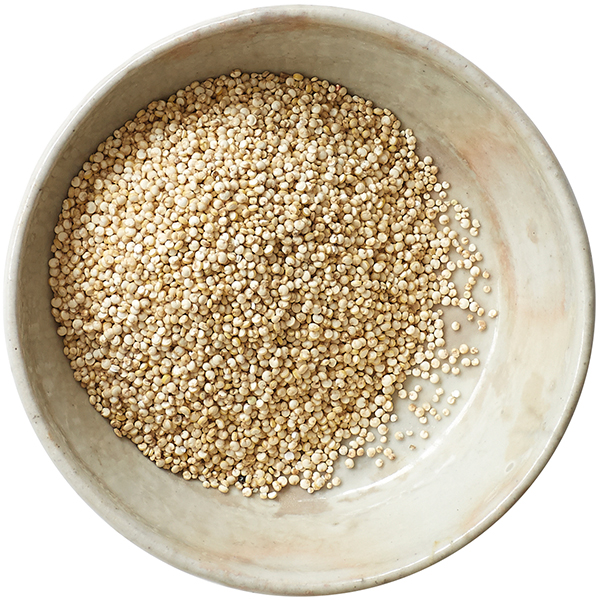
Quinoa
Quinoa is a small round grain that has a slightly bitter flavour and a firm texture when cooked. Discovered by the Incas, quinoa was first grown thousands of years ago, and today the most widely cultivated varieties are white, red, and black. Due to its high oil content, quinoa is best stored in an airtight container in the fridge.

Buckwheat
Originating from Asia, buckwheat is a fruit seed related to rhubarb and sorrel and has a unique triangular shape. Buckwheat is one of the healthiest, nuttiest, and most versatile whole grains. It is available unroasted or roasted. Stored correctly in a sealed container in a cool, dry place, whole buckwheat can last for up to 12 months.

Teff
Teff is a tiny grain, similar in size to a poppy seed, and is available in a variety of colours, including white, red, and dark brown. Found predominantly in Ethiopia and Eritrea, teff can thrive in difficult conditions, including waterlogged soils and during droughts. Stored in a tightly sealed plastic or glass container, teff will keep for up to 12 months.
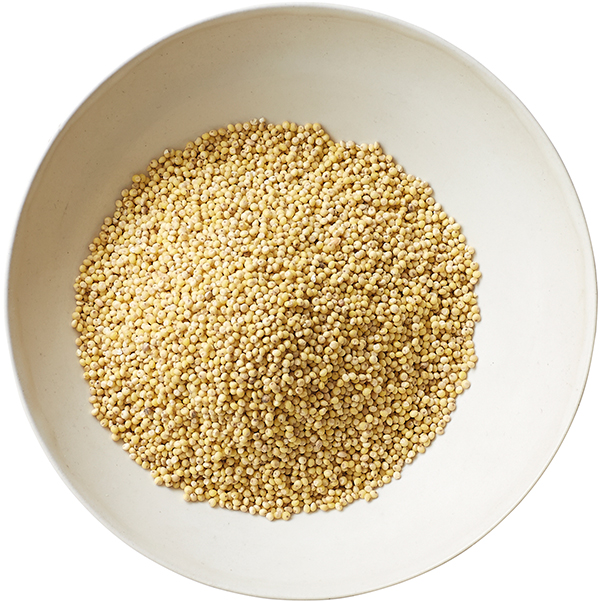
Millet
Millet is the name given to a group of small round grains, and the hulled variety is most commonly available. It was widely used in Asia before rice became the staple grain in the region. Millet becomes rancid fairly quickly, but, if kept in a sealed container, it will remain fresh for two months if stored in a cupboard, or for four months in the fridge.

Cornmeal
Cornmeal, also often referred to as polenta, is believed to have been discovered by Native Americans circa 5000 BC. It is derived from ground, dried corn and its consistency can be fine, medium, or coarse. Cornmeal can retain its freshness for up to 12 months when sealed and stored in a cool, dry place.
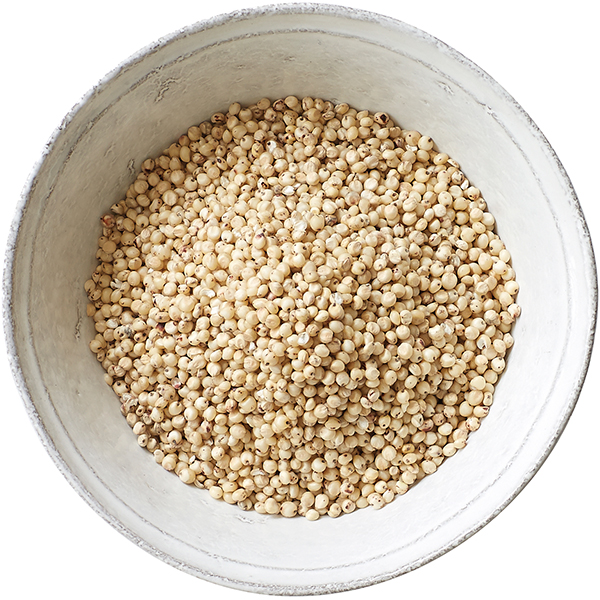
Sorghum
Native to Africa, Sorghum is a small, round grain, ranging in colour from white and brown to red and black. White sorghum is most commonly used and can be ground and substituted for wheat flour. Left whole, it makes fantastic popcorn. Stored in a container in a cool, dark place, it will keep for at least 12 months.
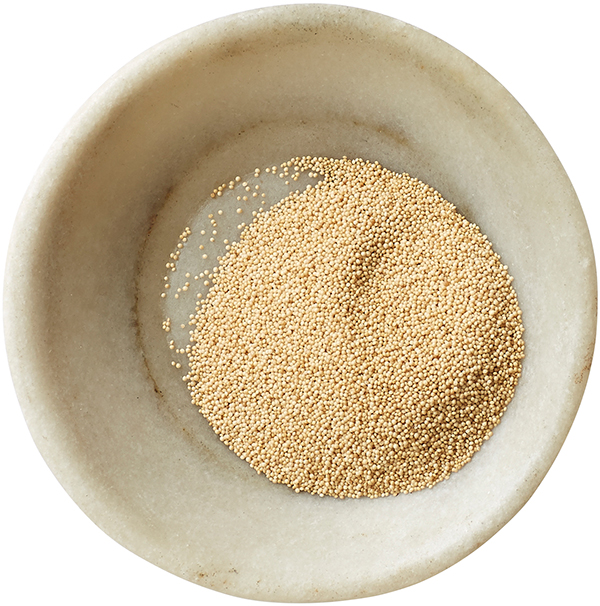
Amaranth
Amaranth is a tiny seed with a nutty flavour that was discovered more than 8,000 years ago by the ancient Aztecs, who relied on it as one of their staple foods. Amaranth will lose its flavour and become bitter if it is stored in a warm location, but it will keep well for up to 12 months in a cool, dry cupboard.
GRAINS CONTAINING GLUTEN
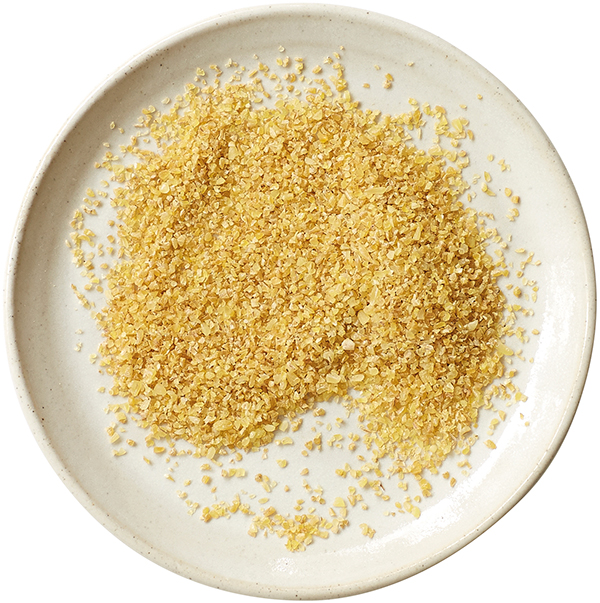
Bulgur wheat
Bulgur wheat is parboiled, dried, then cracked, and is pale brown in colour with an irregular shape. When cooked, it has a delicious nutty flavour and a chewy texture. It is popular in Middle Eastern and Mediterranean cuisines. This grain should be stored in an airtight container and keeps well in a cool, dry place for up to a year.

Barley
A fabulously versatile grain, barley has a long and interesting history originating in Ethiopia and South East Asia over 10,000 years ago. The most common form is pearl barley, which has the outer husk and bran layers removed. Barley can have a shelf life of up to one year if stored in an airtight container in a cool place.

Kamut
Kamut is a trademark name for a type of khorasan grain, believed to have derived from ancient Egypt. It is a brown grain with a long shape, similar to basmati rice, that has a nutty flavour and a chewy texture when cooked. If stored in an airtight container away from heat and moisture, kamut may keep for over 12 months.
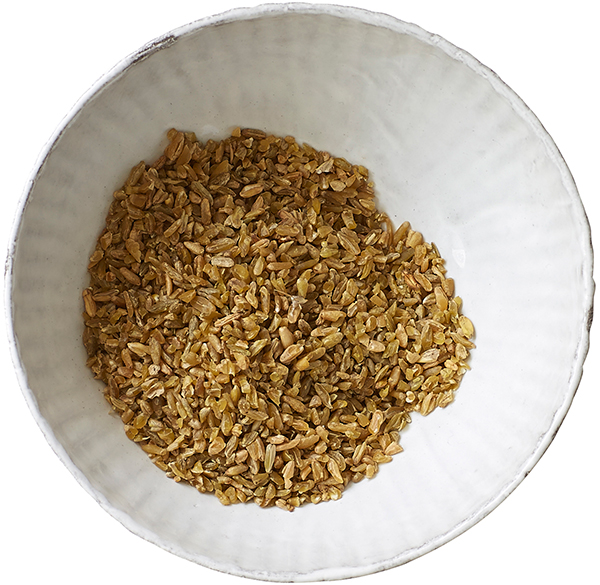
Freekeh
Freekeh is an ancient Middle Eastern grain and is actually wheat that is harvested early, while the grains are still green. The kernels are roasted, dried, and rubbed, resulting in a slightly smoky flavour and nutty texture. The grain should be stored in a sealed jar and will retain its flavour and freshness for up to a year.
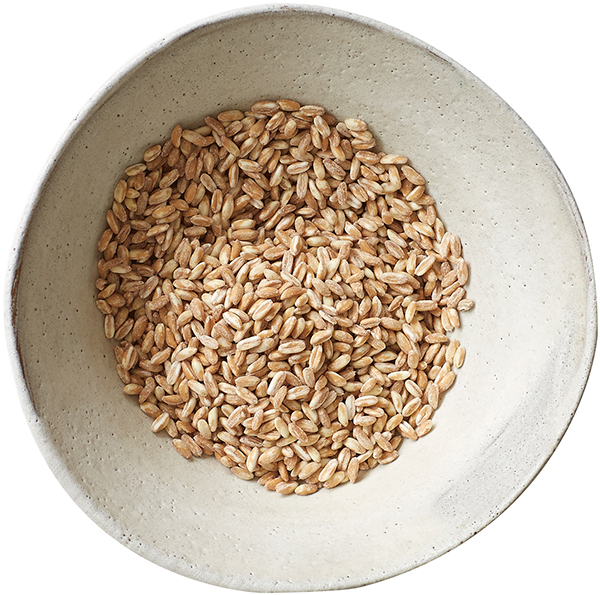
Farro
Farro is the Italian name for emmer wheat, a hard wheat from western Asia. Similar in texture to pearl barley, farro is popular in Italy for its distinctive nutty roasted flavour and chewy texture. It is versatile and can be added to soups, risottos, and salads. Farro will keep for up to one year if stored in a sealed container in a cool, dark place.
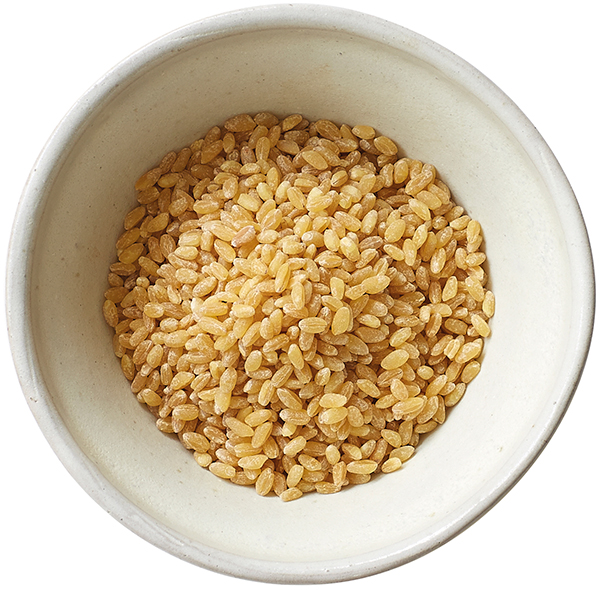
Wheat berries
Wheat berries are not berries, but the whole kernels from a wheat plant with the husks removed, and are available as a hard or soft grain. They have a delicate, creamy, nutty flavour and are a light, reddish brown colour. Wheat berries can be ground into flour or used whole and should be stored in a cool, dry place.
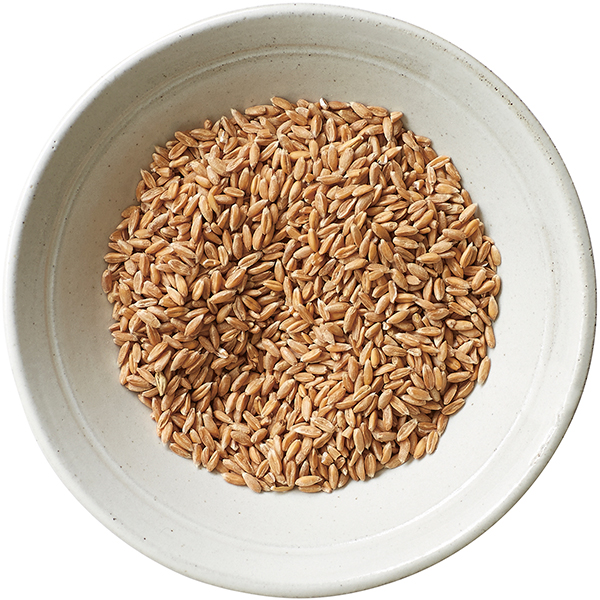
Spelt
Originating in Iran and parts of southern Europe, spelt is a relative of wheat and is one of the oldest grains. It has an oval-like shape and a characteristic nutty flavour. This grain can be used whole or can be ground into flour. Stored in a cool, dry place and sealed tightly, spelt will remain fresh for at least 12 months.
Perfectly Cooked
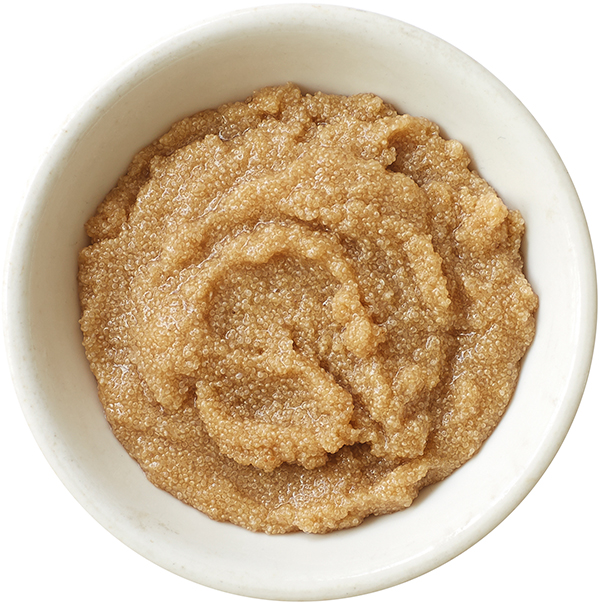
Cooked amaranth
Amaranth should be cooked one part grain to three parts boiling water, then simmered gently for about 25 minutes. Cooked amaranth is rather sticky, but remains crunchy on the outside and soft inside.
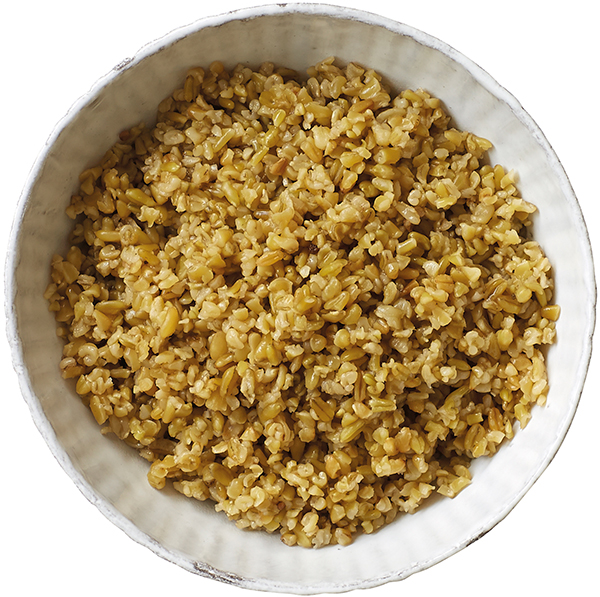
Cooked freekeh
Freekeh is extremely easy to cook. The cooking times and liquid ratios vary depending on whether you are using wholegrain or cracked freekeh, so follow the directions on the pack.
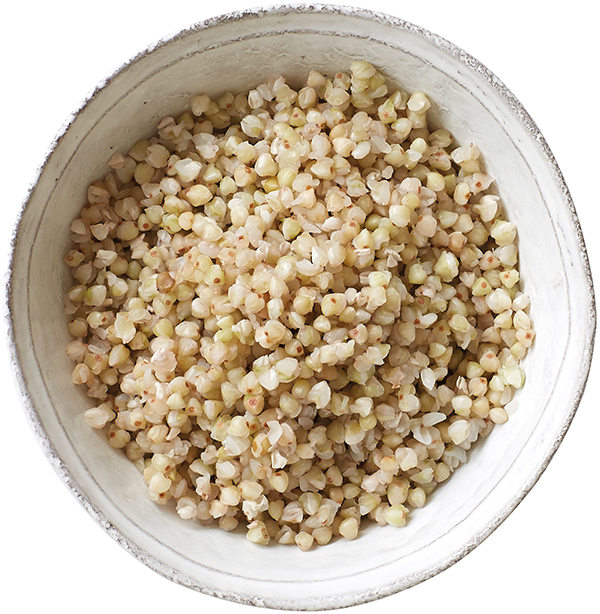
Cooked buckwheat
Buckwheat should be rinsed thoroughly before cooking. Add one part buckwheat to two parts boiling water or stock and cook for about 12–15 minutes. It also cooks well by absorption or steaming methods.

Cooked farro
Farro is available in different varieties, and the wholegrain kind takes longer to cook than semi-pearled or pearled. The easiest way to cook it is in boiling water (in a 1:2 ratio of grain to water) for approximately 15–20 minutes. Its chewy texture makes farro a fantastic substitute for rice or pasta.
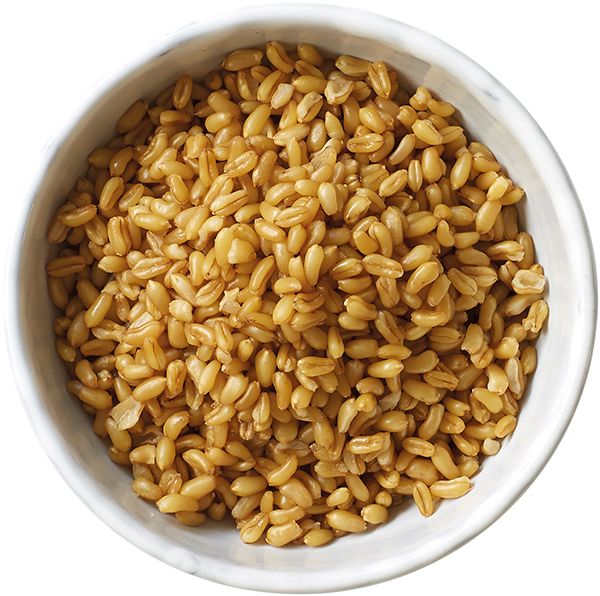
Cooked kamut
Pre-soaking kamut is optional but will significantly speed up the cooking process. Bring the measured water to the boil (use a 1:2 ratio of grain to water), add the drained, soaked grain, then cover, and simmer for 30–40 minutes. Spelt can be cooked in a similar way.

Cooked quinoa
Rinse quinoa before cooking, to remove the bitter coating. Boil for 10–15 minutes. The cooked grains quadruple in size and become translucent. Millet can be cooked similarly, but does not need rinsing.
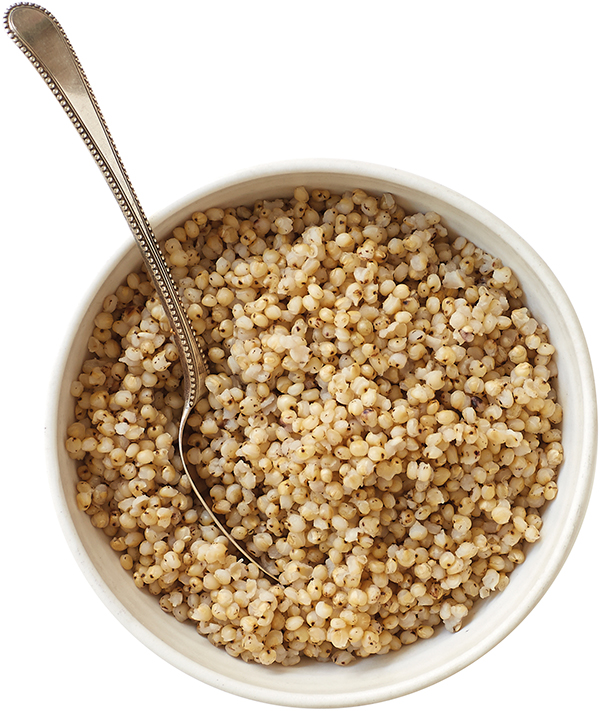
Cooked sorghum
Rinse sorghum before cooking, then cook in a ratio of one part grain to three parts water or stock. Bring to the boil in a pan with a tight-fitting lid, then simmer for up to an hour, until tender.

Cooked teff
Cooking teff depends on how it is being served. It can be cooked in boiling water or sprinkled over soups, salads, or baked goods, adding flavour and texture. It is also eaten as a cereal.

Cooked wheat berries
Cook wheat berries in a 1:2 ratio of grain to water. Add the grains to boiling water in a pan, cover, and simmer for about 60 minutes, until the grains are soft. Soaking wheat berries overnight can help to reduce the cooking time.
FLOUR AND FLAKES
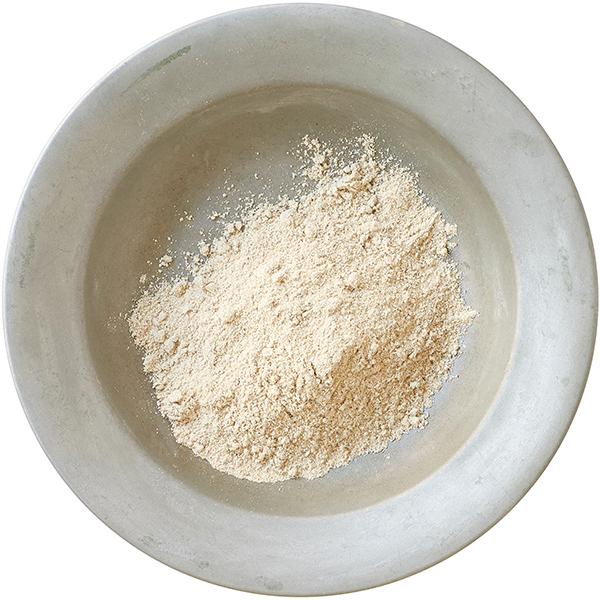
Amaranth flour
Amaranth flour is perfect for gluten-free cooking and baking, and can be used in cake, biscuit, bread, and pastry recipes.
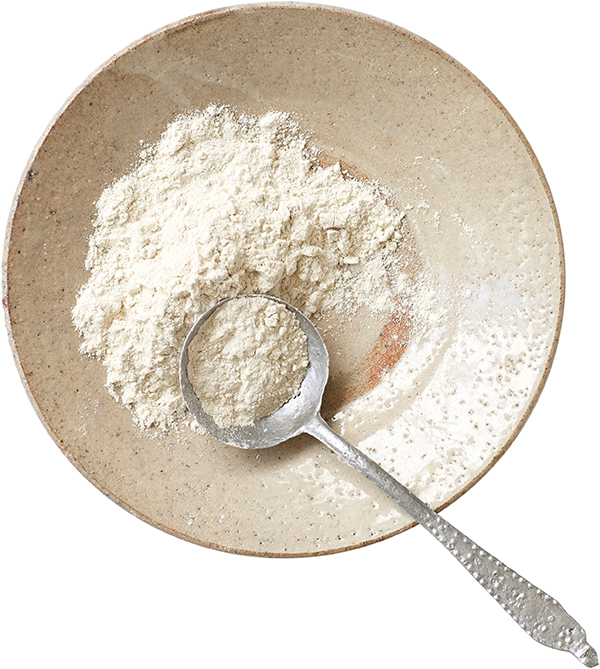
Buckwheat flour
Gluten-free and ideal for making pancakes, scones, and biscuits, this flour can be added to other flours for bread making.

Kamut flour
This wheat flour has a smooth, buttery, and nutty flavour. It can be substituted in any recipe that uses regular wheat flour.
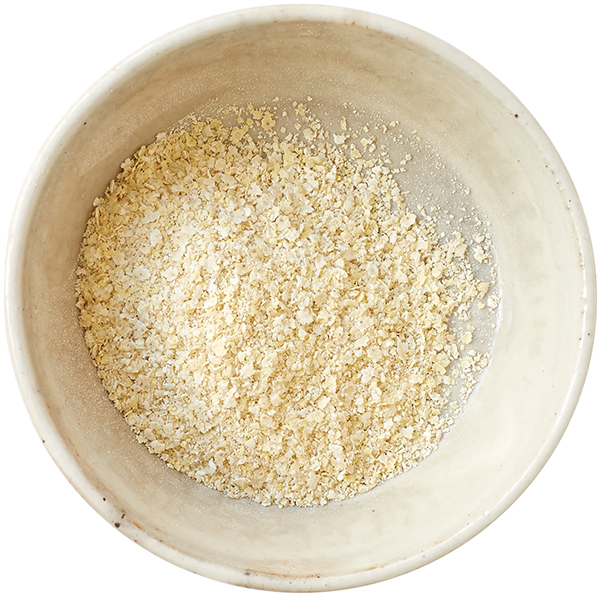
Millet flakes
Wheat- and gluten-free, they are often used in muesli or porridge, or in crumbles and cookies for added texture.
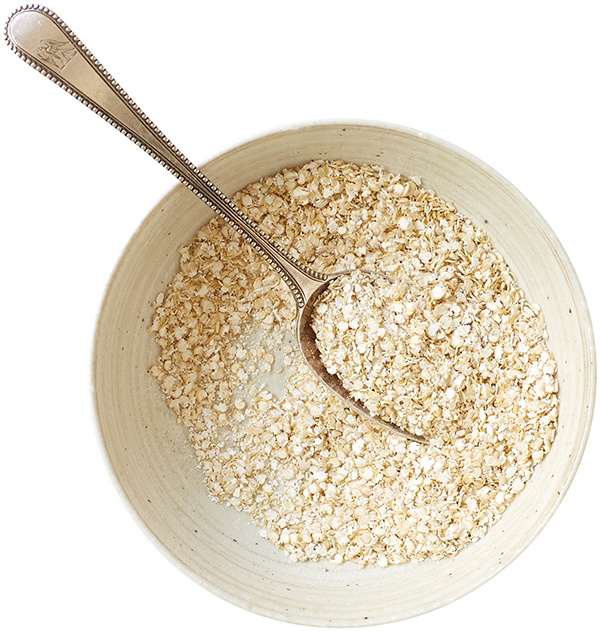
Quinoa flakes
Made by flattening unprocessed, raw quinoa seeds, these are high in protein, gluten-free and can be used for muesli or porridge.

Teff flour
A 100 per cent whole flour, it is creamy brown in colour with a unique sweet and malty flavour and is ideal for baking.
Grain Power
KNOW YOUR NUTRIENTS
| NUTRIENTS | GOOD FOR |
| Protein | general health and growth |
| Carbohydrates | providing energy |
| Calcium | bones and teeth; regulating muscle contractions |
| Fibre | digestion; preventing heart disease and diabetes |
| Iron | making red blood cells |
| Magnesium | muscle and nerve function; controlling glucose levels; regulating blood pressure |
| Phosphorus | bones and teeth; maintaining vital organs |
| Potassium | regulating blood pressure; keeping kidneys healthy |
| Sodium | muscles and nerves |
| Zinc | growth and development; taste and smell |
| Copper | maintaining vital organs; metabolism |
| Manganese | bones; producing collagen |
| Selenium | reproduction; metabolism; protecting against infection |
| VITAMINS | GOOD FOR |
| Thiamin (B1) | metabolism; processing energy |
| Riboflavin (B2) | building blood cells; metabolism |
| Niacin (B3) | processing energy; protecting against free radicals; metabolism |
| Pantothenic (B5) | processing energy; building hormones; immune system |
| Pyridoxine (B6) | proper growth; organ development; healthy blood; good cholesterol levels |
| Folic Acid (B9) | blood cells; regulating the nervous system (essential during pregnancy) |
| Vitamin C | blood cells; healing wounds |
The goodies in grains
The calorific content and amounts of protein, carbohydrates, fibre, and significant levels of minerals and vitamins are listed here per portion (45g/11/2 oz dry weight) of each grain featured in the guide. The grains also contain traces of other nutrients.
Carbohydrates 29.36g Fibre 3.0g
Good source of iron; copper; selenium; Vitamin B6
Excellent source of magnesium; phosphorus
Provides 50% of RDI of manganese
Carbohydrates 33.7g Fibre 7.8g
Good source of magnesium; phosphorus; copper; Vitamin B3
Excellent source of manganese; selenium; Vitamin B1
Carbohydrates 32.18g Fibre 4.5g
Good source of phosphorus; Vitamins B2 and B3
Excellent source of magnesium; copper; manganese
Carbohydrates 34.14g Fibre 8.2g
Good source of magnesium; phosphorus; Vitamin B3
Provides 50% of RDI of manganese
Carbohydrates 34.60g Fibre 3.3g
Good source of magnesium; phosphorus; manganese; selenium; Vitamins B2 and B3
Carbohydrates 32.55g Fibre 4.4g
Good source of magnesium; zinc
Excellent source of Vitamin B3
Carbohydrates 32.14g Fibre 6.4g
Good source of calcium; magnesium; potassium; zinc; Vitamins B1 and B2
Excellent source of iron; copper
Carbohydrates 31.76g Fibre 5.0g
Good source of phosphorus; potassium; zinc; Vitamin B3
Excellent source of Vitamin B1
Provides 50% of RDI of manganese; selenium
Carbohydrates 32.78g Fibre 3.8g
Good source of magnesium; phosphorus; copper; Vitamins B1 and B3
Excellent source of manganese
Carbohydrates 28.87g Fibre 3.2g
Good source of iron; copper; Vitamins B1 and B6
Excellent source of magnesium; phosphorus; manganese; folate
Carbohydrates 28.87g Fibre 3.2g
Good source of phosphorus; Vitamin B6
Excellent source of magnesium
Carbohydrates 28.87g Fibre 3.2g
Good source of iron; magnesium; phosphorus; copper; manganese; Vitamins B1 and B3
Provides 50% of RDI of manganese
Carbohydrates 31.59g Fibre 3.6g
Good source of iron; phosphorus; zinc; Vitamins B1 and B6
Excellent source of magnesium; copper
Provides 50% of RDI of Vitamin C and 100% of RDI of manganese
Carbohydrates 32.55g Fibre 5.74g
Good source of iron (white); magnesium; phosphorus; Vitamins B1 and B3
Excellent source of selenium
Provides 50% of RDI of manganese (red)
Good source = circa 10% of the recommended daily intake
Excellent source = circa 20% of the recommended daily intake
Be Prepared

Rinse
Most grains do not need rinsing, except quinoa, but it is beneficial. Run the grain under cold water in a fine mesh sieve immediately before cooking.

Soak
Soak grains that take longer to cook. Place the grain in a bowl, cover with cold water, and leave it overnight. Drain and rinse before cooking.

Pop
Heat a pan over a medium-high heat. Add a small amount of the grain. As it heats up, the grain will start to pop. Watch it carefully, so it doesn’t burn.

Roast
Roasting adds a nutty or crunchy taste. Spread the grain on a baking sheet and bake for about 5 minutes, or according to the recipe’s instructions.

Toast
Toasting can enhance a grain’s flavour. Heat a pan over a medium-high heat and add the grain. Shake the pan gently so that the grain turns an even colour.
Cook the Perfect Grain

Boil
1. For information on cooking times and liquid-to-grain ratio, see section Perfectly Cooked. To cook all grains, you can either bring the grain and liquid to the boil or add the grain to boiling water.
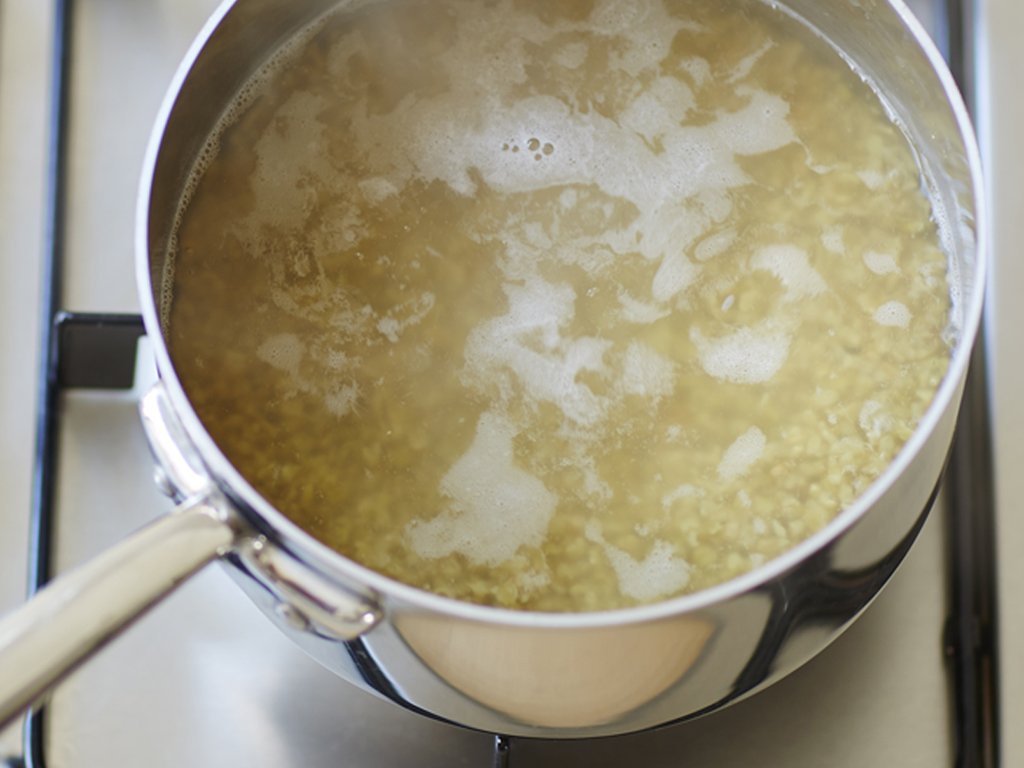
2. Reduce the heat and simmer until the grain is fully cooked. Some grains will absorb the water, and others will need to be drained after cooking.
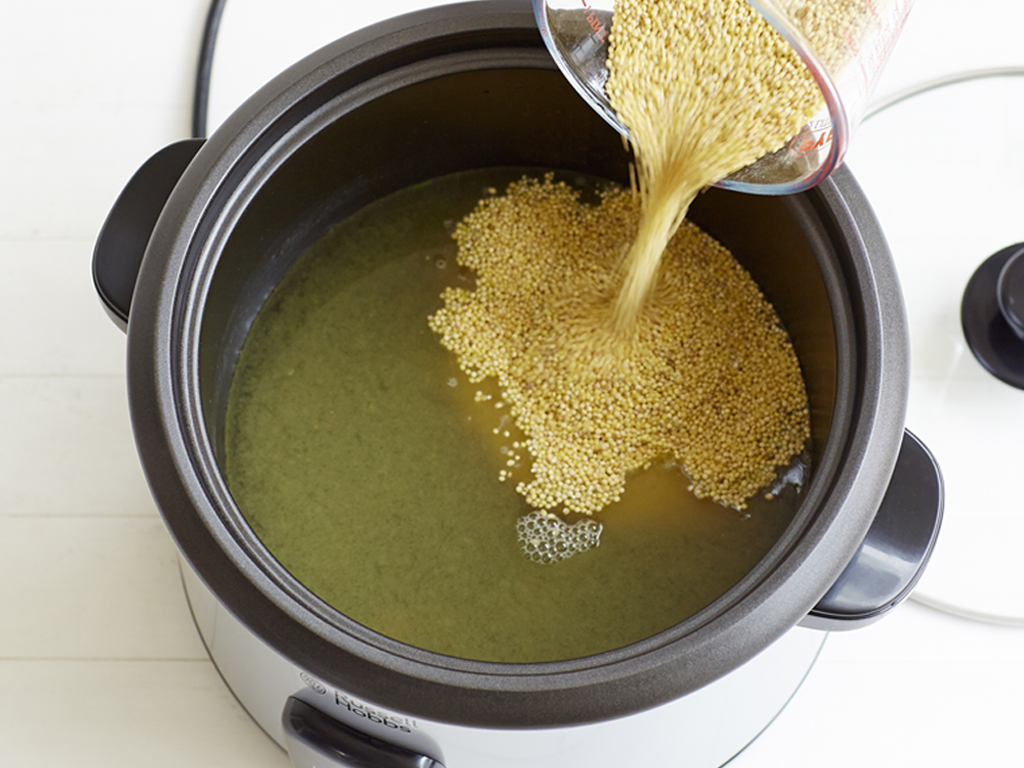
Using a rice steamer
An easy way to cook grains, the benefit of a rice steamer is that once you have added the liquid and grain, you can leave it to do its work. Instructions and timings for using individual steamers will vary, but the results are good.
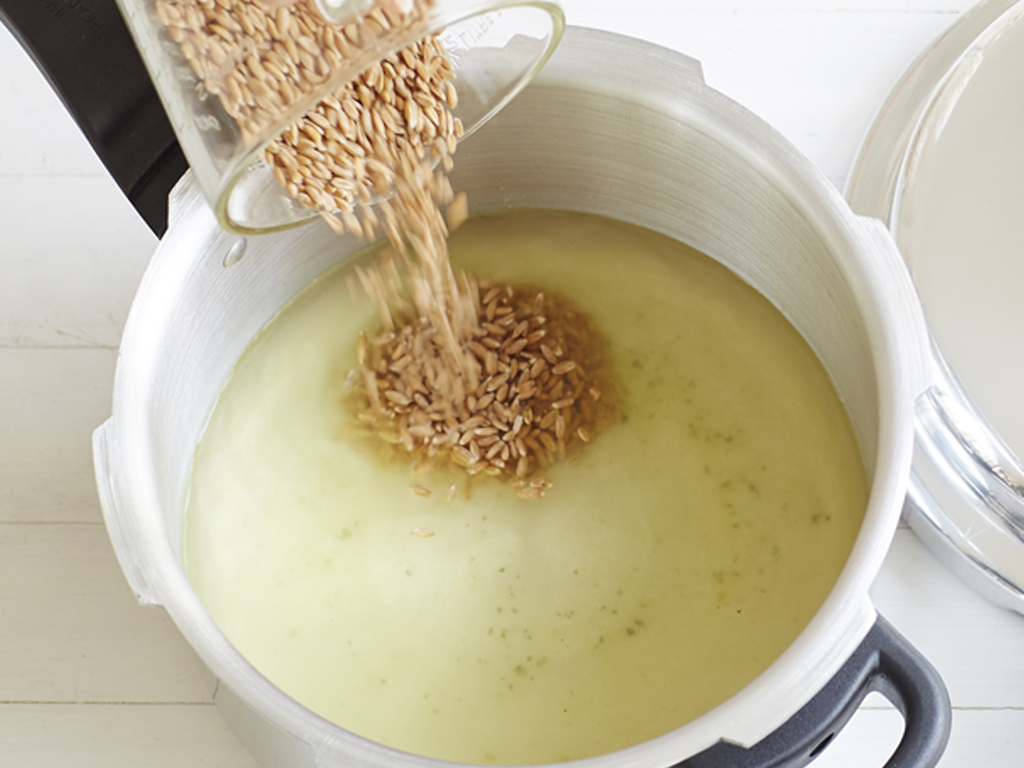
Using a pressure cooker
This is ideal for cooking wheat berries, barley, spelt, and kamut, which all have longer cooking times. But all grains should cook in about half the time. Treat the grain as you would rice, but adjust the timing according to the grain.
STICKY MATTERS – A COUPLE OF HANDY TIPS
It takes a little while to get accustomed to cooking different grains and, as with rice and pasta, you may run into some common problems.
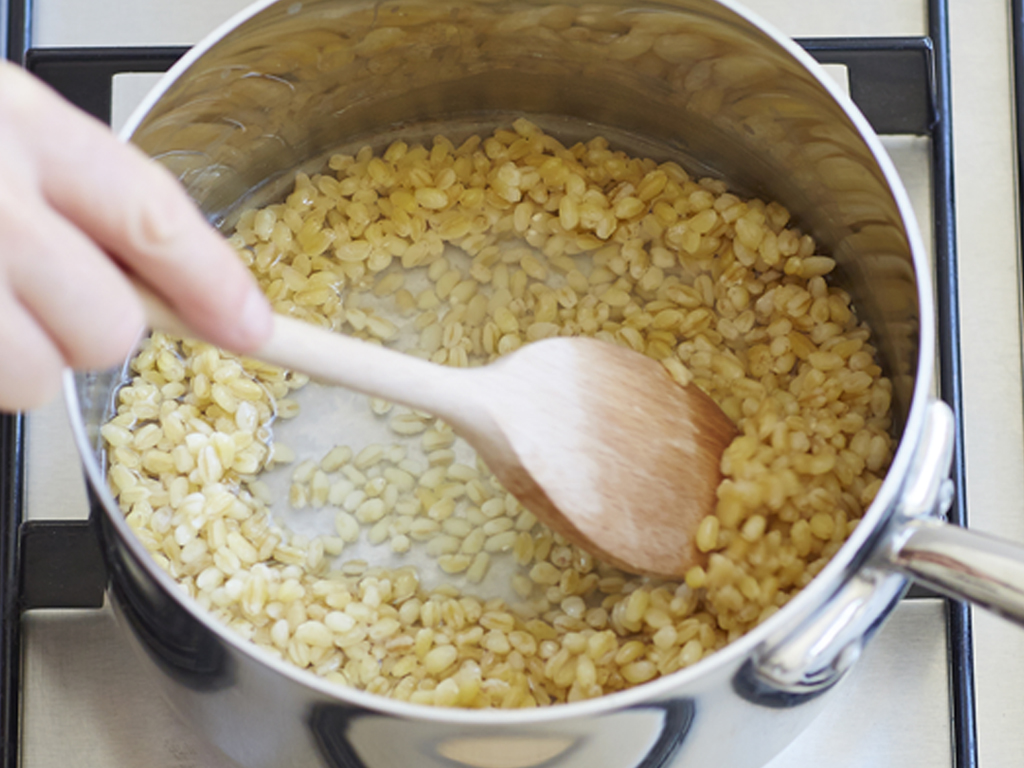
If your grains get stuck to the bottom of the saucepan, add a very small amount of water while the heat is on low and use a wooden spoon to loosen the grains. Do this until the water has been absorbed.

To soak up extra moisture, turn the heat off, drape a tea towel over the pan, and place the lid on top. Let it sit for another 5–10 minutes.
Grain Teasers

Making granola
1. To prepare the granola, preheat the oven to 150°C (300°F/Gas 2), then mix the dry ingredients together in a large bowl. Pour over the wet mixture of honey (or maple syrup), oil and any additional ingredient, and mix well with a spoon until combined.

2. Place the granola mixture on a baking sheet and spread evenly. Bake for 30 minutes until crispy, then transfer to a plate and leave to cool.

Making polenta
1. Pour the measured water into a pan and bring to the boil, reduce the heat, then gradually add the weighed polenta, stirring continuously. Stir for a minute or two until it starts to thicken.

2. Reduce the heat and continue stirring until the polenta begins to come away from the sides of the pan. Polenta can take 45 minutes to cook, while instant varieties can be ready in about 5 minutes.

3. To use as slices, transfer the polenta to a greased baking tray and spread it with a spatula until it is level. Allow the polenta to stand for 30 minutes to cool and firm up, then cut into slices.

4. Once the polenta has been cut into slices, heat some oil and butter in a griddle pan over a medium heat, and fry the polenta for 2–3 minutes on each side, until golden.

Making risotto
1. To prepare risotto, heat butter and oil in a large non-stick pan and gently fry the onions, and any additional vegetables, until soft. Add the grain, stirring continuously, until shiny and transparent.

2. Add white wine, if using, and simmer over a gentle heat until evaporated. Pour over the hot stock, a ladleful at a time, stirring the mixture with each addition until the stock is fully absorbed.

3. Reduce the heat and simmer the risotto for 30 minutes, stirring occasionally, adding liquid when required until the grain is cooked, but still firm. The risotto should be creamy and slightly wet.

4. Finally, stir in any remaining ingredients, such as grated Parmesan, butter, or fresh herbs. Allow the risotto to stand for 3–4 minutes, so that the flavours develop and the liquid is absorbed.

Making patties
1. To prepare patties, place all the ingredients in a mixing bowl and bring the mixture together using a fork. Divide the mixture into equal portions and carefully roll into balls.

2. Using slightly wet hands, flatten the balls into rounds about 1.5–2cm (1/2–3/4in) thick. Transfer the patties to a plate, cover with cling film, and leave in the fridge to firm up.

Drinks and smoothies
Add liquid to a blender, such as cow’s, soya or almond milk, yogurt, or fruit juice. Then add your choice of fruit, vegetables, and cooked grains and blitz for 1 minute until smooth.
BATCH COOKING AND FREEZING
Batch cooking and freezing grain dishes is a great way to avoid waste and save money. You can freeze most dishes, but always cool them completely before freezing. Place them in a suitable container, leaving some space for expansion, and seal tightly to prevent freezer burn. Label with a date and description.
